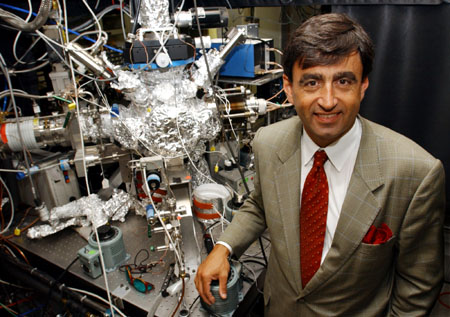Mazur recognized for teaching
Physicist named ‘distinguished teaching scholar’ by NSF

Eric Mazur, Gordon McKay Professor of Applied Physics and Professor of Physics, has won one of the first “Director’s Awards for Distinguished Teaching Scholars,” newly established by the National Science Foundation (NSF).
“This award embodies our priority to recognize the outstanding contributions of scientists and engineers to the leading edge of scientific knowledge at the same time they are advancing the frontiers of education in science, mathematics, engineering, and technology,” said Rita Colwell, director of the National Science Foundation. NSF is the leading funder of nonmedical scientific research in the United States.
“I’m very, very pleased,” Mazur says. “I’ve always thought that teaching goes hand in hand with doing good science. If you do great research, but are unable to communicate the results to the general public, students, and your peers, then you might as well not do any science. The need for science is not determined by science, it’s determined by the general public.”
Mazur, 46, is one of seven scientists who will receive $300,000 over four years to continue and expand their education efforts beyond their institutions. The other recipients include Arthur Ellis, University of Wisconsin; Leah Jamieson, Purdue University; Gretchen Kalonji, University of Washington; Joseph O’Rourke, Smith College; H. Eugene Stanley, Boston University, and Carl Wieman, University of Colorado.
“In addition to being an internationally recognized researcher in physics,” the NSF notes, “Mazur is a national leader in science education. His work has helped energize the movement to change the way introductory science courses for majors and nonmajors are taught.”
In 1988, Mazur received a NSF Presidential Young Investigator Award, given to outstanding researchers at the beginning of their careers. His achievements include the discovery of black silicon, a new material that could lead to more efficient solar cells, communications by light, and monitoring the environment for evidence of global warming (see Dec. 9, 1999, Gazette).
The Council of Scientific Society Presidents gave Mazur its award for outstanding achievement in educational research in 1999. This prize cites him for “stellar research leadership in peer learning and his enduring impact upon science education.” That same year, the Harvard Faculty of Arts and Sciences named him one of six outstanding undergraduate teachers (see March 11, 1999, Gazette). That honor won him the additional title of Harvard College Professor.
Getting from wrong to right
Mazur developed “Peer Instruction” after finding that students in undergraduate physics could plug values into formulas and get the right answers, but they didn’t clearly understand the concepts behind those answers. To gauge what students understand and don’t understand, Mazur uses the latest technology to continually question students on material from reading assignments and classroom lectures.
He asks questions in the classroom and gives students time to discuss possible answers. Students vote on the answers with the help of a handheld device. If he sees that understanding is low, Mazur goes over the material again. “There’s no point in proceeding with the lecture when students don’t understand the material you’ve already covered,” he says.
The students confer in small groups before voting on an answer, and this has proved to be a valuable tool for learning. “The amazing thing,” Mazur says, “is the students who are right invariably convince those who are wrong. I consider myself a coach more than a teacher.”
Ten years of assessment have conclusively shown that Peer Instruction helps students to understand underlying concepts substantially better that with traditional lecturing, according to NSF. The method has been adopted and adapted by thousands of instructors worldwide across a variety of disciplines, including chemistry and astronomy.
Mazur says he will use the $300,000 award to set up a Web site to help science teachers adopt Peer Instruction or similar collaborative learning techniques. The NSF funds will be supplemented by $172,000 from Harvard’s Division of Engineering and Applied Sciences. This fall, faculty at Harvard and other universities will begin testing the Web site.
“NSF’s award for combining scholarship and teaching addresses one of the problems of science education,” Mazur says. “In some institutions, you are either a good scientist or a good teacher. NSF has taken the position that the two are complementary, not mutually exclusive. It’s great to see the combination finally being recognized nationally.”




